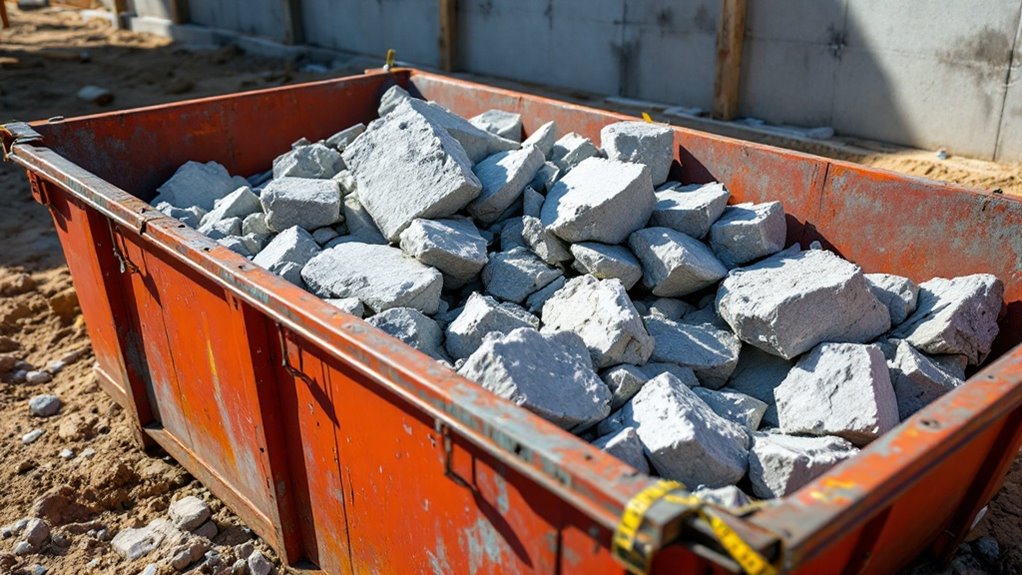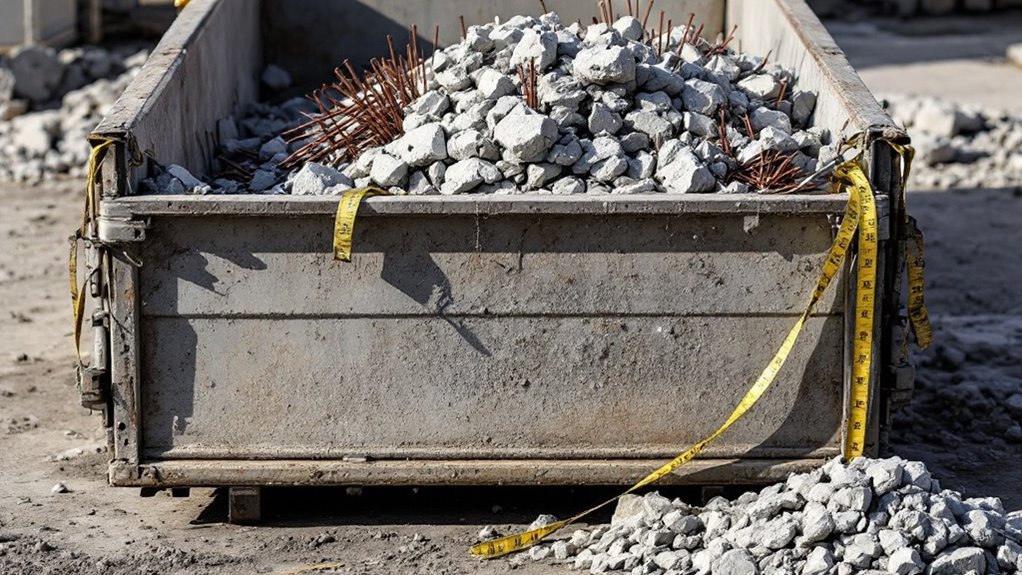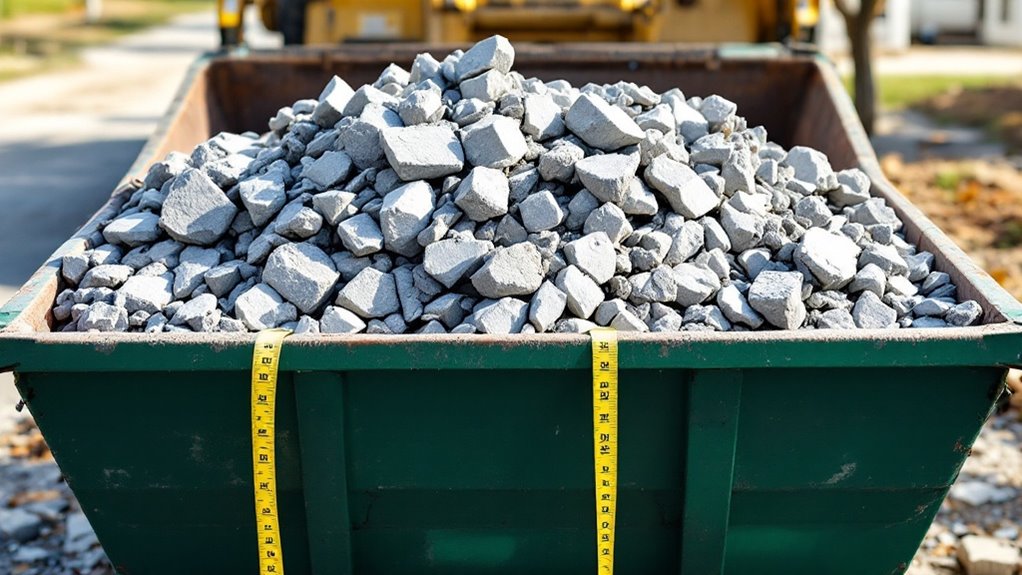You’ll typically fit between 2-7 tons of concrete in a standard roll-off dumpster, depending on the size you choose. A 10-yard container holds 2-3 tons, a 20-yard fits 4-5 tons, and a 30-yard manages 6-7 tons of concrete. Most providers recommend filling the dumpster only halfway with concrete due to weight restrictions and transportation safety. For the best results, you’ll want to understand proper loading techniques and weight calculations.
Key Takeaways
- 10-yard dumpsters hold 2-3 tons of concrete, 20-yard hold 4-5 tons, and 30-yard dumpsters accommodate 6-7 tons.
- Most dumpster providers restrict concrete loading to 50% capacity for safe transportation and weight distribution.
- One cubic yard of concrete weighs approximately 2 tons, requiring careful calculation before ordering a dumpster.
- Weight limits vary by provider and local regulations, making it essential to verify restrictions before renting.
- Concrete should be broken into 2-foot chunks and evenly distributed across the dumpster floor for proper weight balance.
Understanding Dumpster Sizes and Weight Limits

Three common dumpster sizes are available for concrete disposal: 10-yard, 20-yard, and 30-yard containers. When you’re planning your concrete disposal project, you’ll need to examine both the volume and weight limits of each size. A 10-yard dumpster typically holds 2-3 tons of concrete, while a 20-yard can handle 4-5 tons, and a 30-yard can handle 6-7 tons.
You’ll want to check with your local dumpster provider about specific weight restrictions, as they can vary by region and company. Most providers won’t fill a dumpster more than halfway with concrete due to transportation safety regulations. If you’re working on a large demolition project, you might require multiple dumpsters or scheduled pickups to handle all your concrete waste efficiently. Our specialized equipment trucks are specifically designed to safely transport heavy concrete loads without damaging property during delivery or pickup.
Calculating Concrete Volume and Weight
To calculate concrete volume and weight accurately, you’ll need to measure your concrete in cubic yards and convert it to tons. A single cubic yard of concrete weighs approximately 2 tons (4,000 pounds), making it one of the heaviest materials you’ll dispose of in a dumpster.
You can determine your concrete volume by multiplying the length, width, and depth (in feet) of your concrete pile, then dividing by 27 to convert to cubic yards. For example, if your concrete measures 10 feet long, 10 feet wide, and 1 foot deep, you’ll have 3.7 cubic yards. Multiply this by 2 to get the weight in tons. In this case, your concrete would weigh about 7.4 tons – an important number to know when selecting your dumpster size.
Common Dumpster Options for Concrete Disposal

When choosing a dumpster for concrete disposal, you’ll typically find three main options: 10-yard, 20-yard, and 30-yard containers. Each size offers different capacity limits for concrete disposal, and you’ll want to select the right one for your project needs.
| Dumpster Size | Maximum Concrete Weight |
|---|---|
| 10-yard | 2-3 tons |
| 20-yard | 4-5 tons |
| 30-yard | 6-7 tons |
| 40-yard | Not recommended |
| Roll-off | Varies by provider |
For most residential projects, a 10-yard dumpster works well for small demolition jobs like removing a patio or sidewalk. If you’re tackling larger projects such as foundation removal, you’ll need a 20-yard or 30-yard container. Remember that concrete’s weight often limits how much you can dispose of rather than the dumpster’s volume.
Tips for Loading Concrete Into Dumpsters
Loading concrete into dumpsters requires proper planning and technique to prevent damage and guarantee safety. Start by breaking larger concrete pieces into manageable chunks no bigger than 2 feet across. You’ll want to distribute the weight evenly across the dumpster’s floor to prevent tipping or structural stress.
Begin loading from the back corners and work your way forward, creating stable layers as you go. Don’t toss pieces in randomly – this can damage the container and create unstable loads. If you’re using a wheelbarrow, position it close to the dumpster edge and carefully tip the contents in rather than lifting heavy pieces by hand. Remember to wear protective gear, including work gloves, steel-toed boots, and safety glasses. When possible, use a ramp to wheel materials directly into the container.
Cost Factors and Rental Considerations

Several key factors influence the cost of renting a dumpster for concrete disposal. You’ll need to contemplate the rental duration, distance from the disposal facility, and local disposal fees. Most companies charge by weight when it comes to concrete, so you’ll want to obtain accurate estimates beforehand.
When you’re planning your project, remember that rental periods typically range from 3-7 days. You’ll save money by having your concrete ready to load when the dumpster arrives. Don’t forget to ask about weight limits and overage charges – concrete is heavy, and exceeding limits can lead to expensive fees.
Many contractors find it worthwhile to compare quotes from different rental companies, as prices can vary enormously in the same area.
Frequently Asked Questions
Can I Mix Different Types of Concrete Waste in the Same Dumpster?
You shouldn’t mix different types of concrete waste, as this can make recycling difficult and may violate disposal regulations. Keep your concrete waste separated for proper handling and disposal.
How Long Can I Keep the Dumpster While Disposing of Concrete?
You’ll typically have 7-10 days with your dumpster rental, but you can extend the time if needed. Just check with your provider about their specific rental terms and fees.
Will Wet Concrete Damage the Dumpster’s Interior?
You’ll want to avoid putting wet concrete in your dumpster, as it’ll harden and bond to the container, causing permanent damage and costly repairs to the rental company’s equipment.
Do I Need Permits to Place a Concrete-Filled Dumpster on Public Property?
You’ll need permits to place any dumpster on public property, and disposing of concrete this way could result in hefty fines and legal issues for you.
Can I Dispose of Rebar Along With the Concrete Chunks?
You’ll want to separate rebar from concrete before disposal. Most dumpster services require metal and concrete to be disposed of separately due to different recycling processes.
Conclusion
You’ll need to carefully consider both volume and weight limits when disposing of concrete in a dumpster. While a 20-yard dumpster might seem spacious, you can typically only fill it about 1/3 full with concrete due to weight restrictions. Remember to calculate your concrete volume beforehand, discuss weight limits with your rental provider, and consider splitting larger loads across multiple dumpsters.